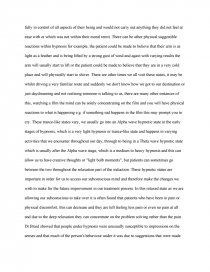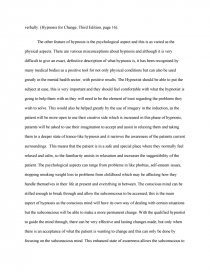What Is Hypnosis
Essay by pittsy • May 29, 2013 • Essay • 2,054 Words (9 Pages) • 1,341 Views
"What is Hypnosis?" Describe the Psychological and physical aspects of hypnosis and discuss the role of relaxation in Hypnotherapy.
Within this essay I will define what hypnosis is and describe the psychological and physical aspects of hypnosis, I will also discuss the role of relaxation in hypnosis. The hypnotist uses varying techniques for hypnosis in order to allow the patient to be in a position to be in a suggestible state. Hypnosis is commonly described as a natural phenomenon. There can be either, a hypnotist and a patient or there can be group hypnosis with a group of people and a hypnotist and there are some people who can learn how to do self-hypnosis with a little practice. There are still many people who are sceptical about the concept or the merits of hypnosis but there is no doubt that hypnosis does exist. There is significant evidence which can be shown in such physical procedures such as EEGs showing brainwave activity, it is simply that it is difficult to actually define what hypnosis is and how it actually works but it appears that the left-hand side of the brain, the analytical side, is turned off and the right hand side of the brain, the non-analytical side, is made more alert. (Doctor, What's the Alternative" 1988)
The word hypnosis means the trance like state which is entered when a hypnotist uses various techniques in order to shut out the conscious mind and get in touch with the sub-conscious, this is done to effect changes in the patient which will benefit them in some way in either a behaviour, a thought process, an emotional situation or a physical problem which the patient desires to change or improve. The hypnotist will usually ask the patient to concentrate on something e.g. a place on the wall or ceiling or ask them to close their eyes in order to focus their attention, the hypnotist will then talk in a slow, quiet comforting manner in order to make the patient relax. The language used is repetitive and calming. The subconscious is responsible for all the things we do automatically e.g. breathing, emotions, hearing, automatic body functions so it is very influential in the way our mind works.
James Baird, a 19th Century surgeon, originated the term "hypnotism" and "hypnosis" based on the word hypnos, which is Greek for "to sleep" (Science.Howstuffworks.com). This was found to be a mistake as we are most definitely not asleep, we are simply in a relaxed trance like state of relaxation, but it was too late to change, this name seemed to stick and that is how it is known even to this day.
During the early stage of hypnosis the physical aspects are as varied as people are individual, there will be no two people in the world who will react the same. The patient will normally start to relax in body and mind and during this stage the body will begin to be in a trance-like state to varying degrees, but this is a very individual experience and although some people may advance quickly and heavily into this relaxed state others may appear more alert and not relax to the same level. The evidence is clear that the patient's state has changed as the heart rate slows and the breathing deepens and slows and they will appear much more relaxed by the obvious signs of reduction in activity, there may also be either a rigidity or limpness to the muscles of the arms, legs and even the face which will become apparent, or the patient may report sensations of tingling or numbness. Sometimes the patient can even show signs of becoming very warm or very cold. This does not mean the patient is completely out of touch with the outside world, the patient will still be in a state which allows them to be responsive to outside stimulants if an emergency occurred they would not have any trouble responding to it but they are still usually very relaxed. There is also a misconception that the patient could be made to do anything the therapist wanted them to do such as making silly noises or acting in an embarrassing way as we see with these stage hypnotists, this is not the case as the patient is still fully in control of all aspects of their being and would not carry out anything they did not feel at ease with or which was not within their moral remit. There can be other physical suggestible reactions within hypnosis for example, the patient could be made to believe that their arm is as light as a feather and is being lifted by a strong gust of wind and again with varying results the arm will usually start to lift or the patient could be made to believe that they are in a very cold place and will physically start to shiver. There are other times we all visit these states, it may be whilst driving a very familiar route and suddenly we don't know how we got to our destination or just daydreaming and not realising someone is talking to us, there are many other instances of this, watching a film the mind can be solely concentrating on the film and you will have physical reactions to what is happening e.g. if something sad happens in the film this may prompt you to cry. These trance-like states vary, we usually go into an Alpha wave hypnotic state in the early stages of hypnosis, which is a very light hypnosis or trance-like state and happens in varying activities that we encounter throughout our day, through to being in a Theta wave hypnotic state which is usually after the Alpha wave stage, which is a medium to heavy hypnosis and this can allow us to have creative thoughts or "light bulb moments", but patients can sometimes go between the two throughout the relaxation part of the induction. These hypnotic states are important in order for us to access our subconscious mind and therefore make the changes we wish to make for the future improvement in our treatment process. In this relaxed state as we are allowing our subconscious to take over it is often found that patients who have been in pain or physical
...
...





